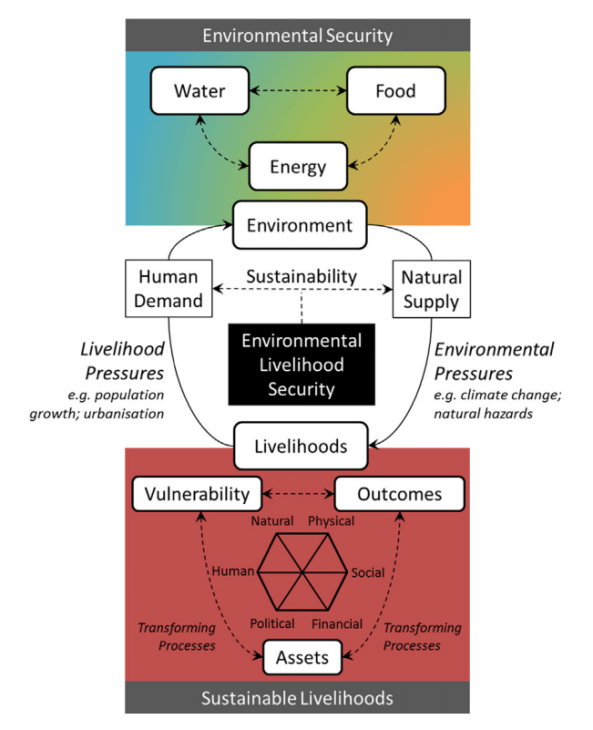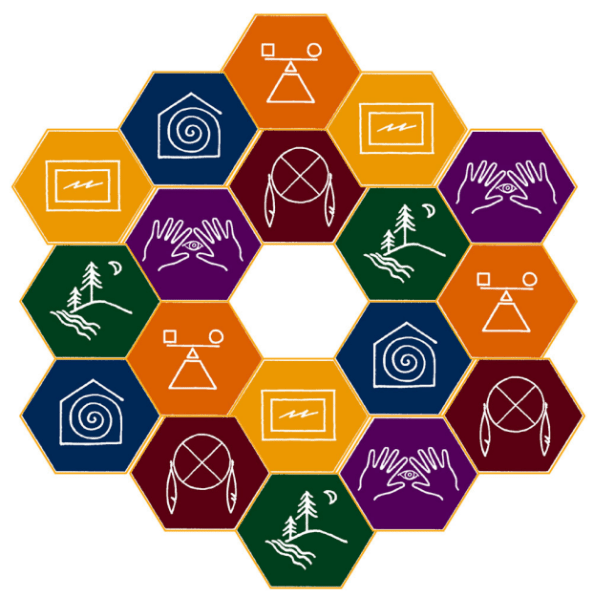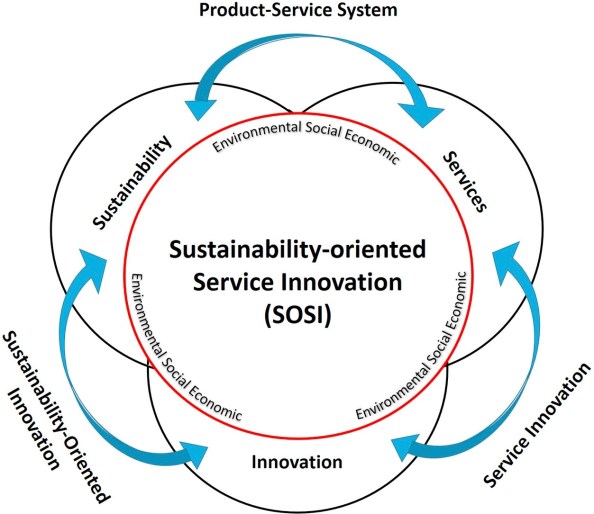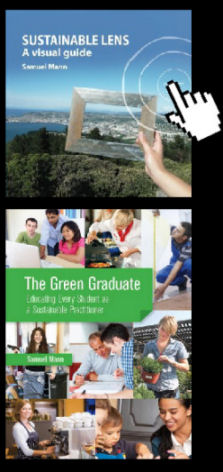
Adding to the collection.
436. Sustainable well-being as two coupled goals (Glasser 2018)

437. Transformative learning for a sustainable future (Laininen 2018)

438. Mmm…Cake. (van Kerkhoff 2013)
Sustainable development framework: three tiers of ultimate goals and four layers of enabling goals. Knowledge governance sits at the dashed line between the two base layers.

439. The nexus: interlinkages across resources and the SDGs. (Bleischwitz 2018)
The main interlinkages across resource use, such as water being used to produce energy and vice versa. Main resource inputs into the chains of other resources are shown at three main delivery stages, illustrated through different shades of colour: primary production; systems of provision through production, distribution, and consumption; and potential secondary use. The figure describes a five-node approach, but fewer dimensions might be feasible following screening, in order to reduce complexities.

440. Sustainable wellbeing achieved through a Stoic framework. (Whitling 2018)
eudaimonic pursuits …prize virtue (or the progress towards it) over and even at the expense of comfort

441. Intenscope (Kocsis 2014, pdf)
The Intensity Scope…a 2D graphical system is a tool which can be used to highlight and communicate basic consumption–population–sustainability relationships.
To correctly read the plot one should: (1) find the object’s perpendicular projection to the axis in question; and, (2) check the contours of the pyramid to identify the correct intensity proportion (%) for the axis in question.
(Note. Sam doesn’t understand this. He tried really hard).

442. Environmental Livelihood Security (Biggs 2015)
The conceptual framework for investigating environmental livelihood security (ELS) combines concepts of the water–energy–food–climate nexus with the capitals of the sustainable livelihoods framework to achieve a sustainable balance between natural supply and human demand to ensure ‘environmental livelihood security’ (Source: adapted from Biggs et al., 2014).

444. Environmental Livelihood Security as a circle (Biggs 2015)
The notion of Environmental Livelihood Security (ELS) conceptualises the links
between water, energy, food and livelihoods which need balance to achieve a
sustainable system. External influencing factors such as climate change, population
growth, and governance can all impact upon attaining ELS.

445. White dress (close to be disallowed, is saved by the “effort” dimension making a diagram). (HuffPost 2015)

446. Sustainable Value Innovation (Orsato 2009)

(note, no chance of positive benefit for environment)
447. Not that. (avoiding #epicfail) (Lloyd-Pool 2013)

448. Pillars as boundaries (Gardner 1991)
Three of the important boundaries that will shape future agricultural policy emphasizing the few possibilities that may exist that meet universal approval.
Although many production systems may pass the rigors of environmental protection, economic security, and social acceptability individually, few will satisfy all the facets necessary for a successful and sustainable agriculture.

449. Edward Barbier’s Venn diagram (1989) The Concept of Sustainable Economic
Development
One basic analytical approach is to view this process as an interaction among three systems: the biological (and other resource) system (BS), the economic system (ES), and the social system (SS).
Original caption:
Sustainable economic development maximises the goals across
the biological and resource system (BS), the economic system (ES), and the social system (SS), as illustrated by the shaded area. In contrast, conventional development approaches maximize only ES goals, and Marxist economies maximizes only ES and SS goals.
Unlike the literal pillars diagram or the three legged stool,
Barbier’s Venn shows that the three pillars are interlinked, interrelated, and inseparable.
Hence, none of these systems can be sacrificed if sustainability is to be maintained.


451. Turtle (Mino Bimaadziwin Partnership)

452. “Western model” (Kealiikanakaoleohaililani and Giardina 2016) (unfortunately no comparable model given for indigenous sustainability science).
Western, global-scale sustainability is a function of three systems operating at the individual, societal, and global scales, as well as their linkages and solutions to complex problems

453. Menominee Nation Sustainable Development Institute’s Model (via Dockry 2016)
Six dimensions of sustainable development in the College of Menominee Nation Sustainable Development Institute’s Model. Menominee Autochthony (their profound sense of place and tie to the land) would occupy the center of the model and represent the Menominee cultural value that has allowed them to balance the tensions among the six model dimensions. Other communities using the model can identify their own cultural values that would allow them to balance the tensions among model elements

Illustration of tensions among dimensions in the College of Menominee Nation Sustainable Development Institute’s Model. Tensions are represented anywhere the model dimension’s borders touch. An unlimited number of tensions can be illustrated by placing dimensions adjacent to each other.

454. Participatory map from Girringun workshop (Robinson et al. 2016)
Example of participatory map created from a sub-group discussion with
Girringun workshop participants. Each branch reflects a core value that trees
provide the Girringun community (e.g. culture), tree roots reflect the knowledge
partnerships that help sustain these values (e.g. partnerships with scientists), clouds reflect attributes that enable these knowledge partnerships to be successful (e.g. social capital) and rocks on the ground represent attributes that present challenges facing these knowledge partnerships (e.g. one-way knowledge exchange)

455. Sacred Purpose (Rinah Rachel Galper, in Gallery of graphic representations of North American Jewish life by Kenissa Network members)

456. Just Transition (Movement Generation Justice & Ecology Project)
Shifting to managing home in concert with the principles of living systems requires aligning three core strategies: building the new, changing the rules, and moving the resources from an extractive to a regenerative economy. All of this must be done in a way that stops the bad and changes the story. Working with the Our Power Campaign, Movement Generation crafted figure 3-4 to illustrate a strategy framework to shift from an extractive economy to regenerative economies. The just transition strategy framework gives a way to understand the underlying threads of the current extractive economy and the envisioned threads weaving regenerative economies together.

457. Mangorewa Kaharoa Te Taumata Trust

458. Wheel with a hint of a system “Catalyzing A Global Sustainable Economy” (Capital Missions Company and Tipping Point Network)

460. Coviability of Social and Ecological Systems (Barriere et al. 2019)

461. 3Hs of biocultural ethic (Rozzi 2015)
The “3Hs” of the biocultural ethic coupled with the three core components identified for Earth Stewardship: habitat/ Earth , habit/ stewardship , and co-inhabitants/ stewards

462. Triad of human interest (Chisholm 2015)

Ecological praxis: A change of heart and mind reflected in action.

464. Integrated assessment (Lamb 2006)

465. Framework for engineers (Lamb 2006 after Fenner 2006)
Incorporating sustainable development into this traditional framework requires
a move into problem boundaries not normally considered by civil engineers. This move has been considered by Fenner et al with the development of a framework based upon values, processes and constraints that form a questioning approach within an eight point framework.

466. Politics of Wellbeing (“Wellebing as a Compass”. Joshua Malkin, via).

467. Moral compass in High-Climate Change World (Grasso and Tàbara 2019)

468. Moral compass in time, space and recipients of moral concern (Grasso and Tàbara 2019 after Tàbara 2017)
Situating the moral compass in an extended cognitive and normative system of reference to guide the development of transformative solutions and sustainable governance arrangements in HECC worlds

469. Is it a bird? Is it a plane. Yes, it’s a bird. Sustainable Tourism in Picton and the Marlborough Sounds (e-Ko Tours)

470. Sustainable growth through a reinvented sampo yoshi approach (Itochi Corporation, Japan).

471. Conceptual understanding of the construction companies with the spectrum of sustainability concepts (Wilkinson 2012)

472. Sustainability oriented service innovation (Calabrese 2018)

473. S 3-Sustainability as Service Science Model (Wolfson 2012)

474. Sustainability as a component of resilience (Marchese 2018)
The more sustainable system loses less critical functionality, and recovers quicker in response to economic, environmental, and social disturbances.

475. Common concepts connecting sustainable development and global change to
urban infrastructure resilience (Shaker et al. 2019).


Posted on August 10, 2019
0